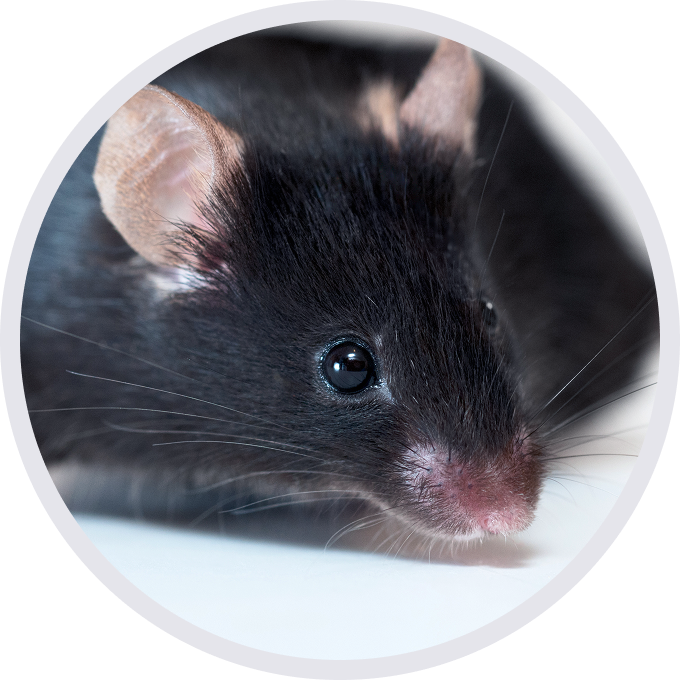
C57BL/6JNifdc-B2mtm1(B2M/HLA-A11.1/H2-D)Bcgen/Bcgen • 112803

| Product name | B-HLA-A11.1 mice |
|---|---|
| Catalog number | 112803 |
| Strain name | C57BL/6JNifdc-B2mtm1(B2M/HLA-A11.1/H2-D)Bcgen/Bcgen |
| Strain background | C57BL/6JNifdc |
이 페이지에서
Gene targeting strategy for B-HLA-A11.1 mice. The B2M gene (Exon1 to Exon3) of mouse were replaced by the sequence encompassing the human B2M CDS and HLA-A*1101 gene that included leader sequence, α1 and α2 domains ligated to a fragment of the murine H-2Db gene containing the α3, transmembrane and cytoplasmic domains.
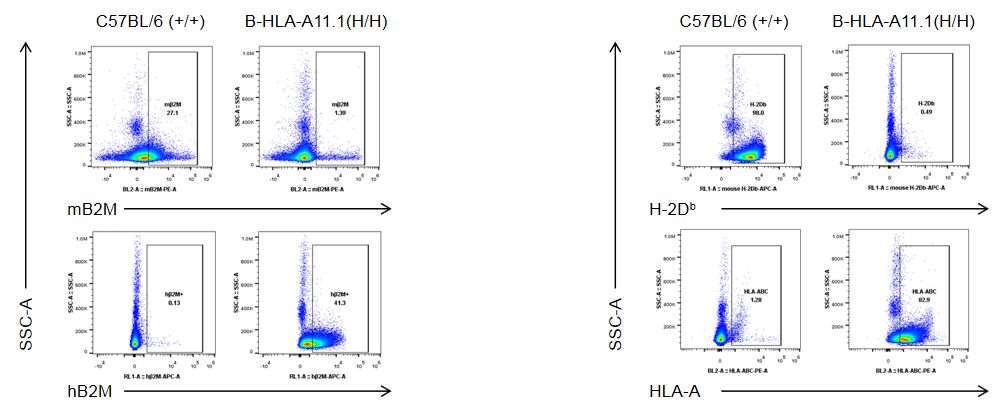
Strain specific B2M and HLA-A expression analysis in homozygous B-HLA-A11.1 mice by flow cytometry. Splenocytes were collected from wild-type C57BL/6 mice (+/+) and homozygous B-HLA-A11.1 mice (H/H) and analyzed by flow cytometry with species-specific anti-B2M and anti-HLA-A antibodies. Mouse B2M and H-2Db were detectable in wild-type C57BL/6 mice. Human B2M and HLA-A11.1 were exclusively detectable in homozygous B-HLA-A11.1 mice but not in wild-type mice.

Analysis of spleen leukocyte subpopulations by FACS. Splenocytes were isolated from female C57BL/6 and B-HLA-A11.1 mice (n=3, 8-week-old). Flow cytometry analysis of the splenocytes was performed to assess leukocyte subpopulations. A. Representative FACS plots. Single live cells were gated for the CD45+ population and used for further analysis as indicated here. B. Results of FACS analysis. Percent of total T cells, B cells, NK cells, dendritic cells, granulocytes, monocytes and macrophages in homozygous B-HLA-A11.1 mice were similar to those in the C57BL/6 mice. Percent of CD8+ T cells were significantly decreased, demonstrating that introduction of hB2M-HLA-A11.1-H-2D in place of mouse B2M may affected the development of CD8 + T cells, which in turn affected the proportion of T cell subtypes in the spleen. Values are expressed as mean ± SEM.
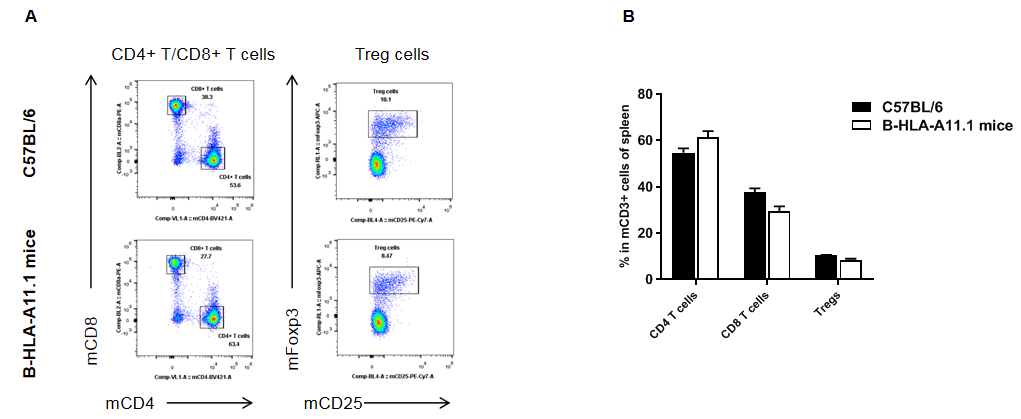
Analysis of spleen T cell subpopulations by FACS. Splenocytes were isolated from female C57BL/6 and B-HLA-A11.1 mice (n=3, 8-week-old). Flow cytometry analysis of the splenocytes was performed to assess leukocyte subpopulations. A. Representative FACS plots. Single live CD45+ cells were gated for TCRβ+ T cell population and used for further analysis as indicated here. B. Results of FACS analysis. The percent of Tregs in homozygous B-HLA-A11.1 mice were similar to those in the C57BL/6 mice. Percent of CD8+ T cells were significantly decreased while percent of CD4+ T cells were significantly increased, demonstrating that introduction of hB2M-HLA-A11.1-H-2D in place of mouse B2M may affected the development of CD8 + T cells, which in turn affected the proportion of T cell subtypes in the spleen. Values are expressed as mean ± SEM.
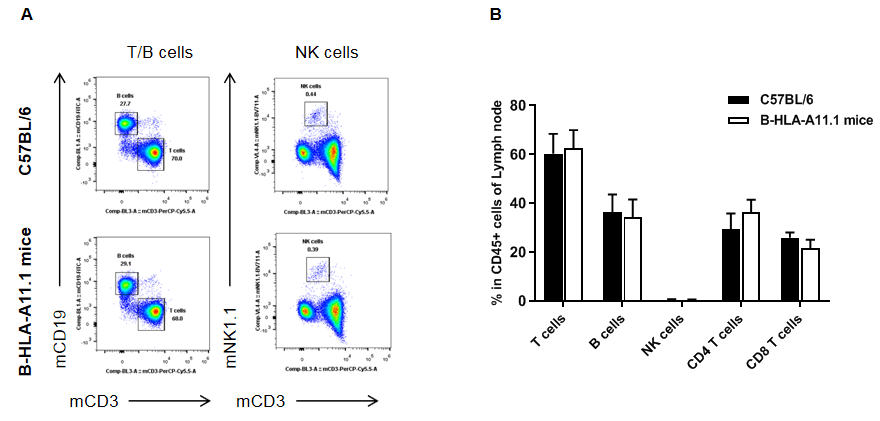
Analysis of lymph node leukocyte subpopulations by FACS. Lymph nodes were isolated from female C57BL/6 and B-HLA-A11.1 mice (n=3, 8-week-old). Flow cytometry analysis of the splenocytes was performed to assess leukocyte subpopulations. A. Representative FACS plots. Single live cells were gated for the CD45+ population and used for further analysis as indicated here. B. Results of FACS analysis. Percent of total T cells, B cells, NK cells, dendritic cells, granulocytes, monocytes and macrophages in homozygous B-HLA-A11.1 mice were similar to those in the C57BL/6 mice. Percent of CD8+ T cells were significantly decreased, demonstrating that introduction of hB2M-HLA-A11.1-H-2D in place of mouse B2M may affected the development of CD8 + T cells, which in turn affected the proportion of T cell subtypes in the lymph nodes. Values are expressed as mean ± SEM.
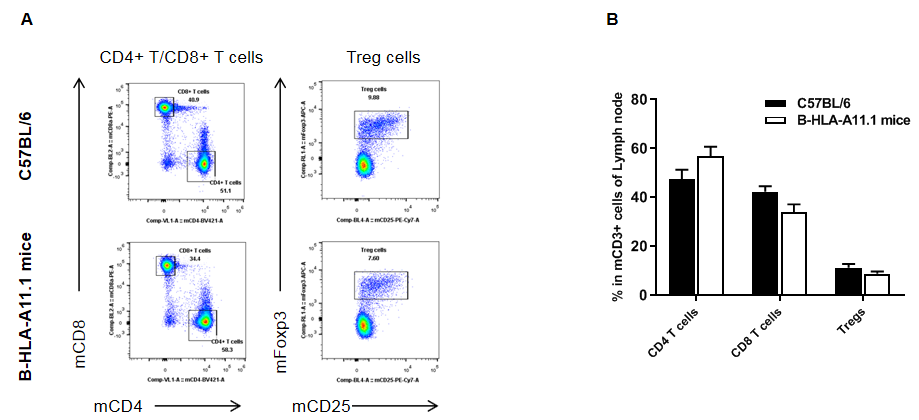
Analysis of lymph node T cell subpopulations by FACS. Lymph nodes were isolated from female C57BL/6 and B-HLA-A11.1 mice (n=3, 8-week-old). Flow cytometry analysis of the splenocytes was performed to assess leukocyte subpopulations. A. Representative FACS plots. Single live CD45+ cells were gated for TCRβ+ T cell population and used for further analysis as indicated here. B. Results of FACS analysis. The percent of Tregs in homozygous B-HLA-A11.1 mice were similar to those in the C57BL/6 mice. Percent of CD8+ T cells were significantly decreased while percent of CD4+ T cells were significantly increased, demonstrating that introduction of hB2M-HLA-A11.1-H-2D in place of mouse B2M may affected the development of CD8 + T cells, which in turn affected the proportion of T cell subtypes in the lymph nodes. Values are expressed as mean ± SEM.

Analysis of blood leukocyte subpopulations by FACS. Blood cells were isolated from female C57BL/6 and B-HLA-A11.1 mice (n=3, 8-week-old). Flow cytometry analysis of the splenocytes was performed to assess leukocyte subpopulations. A. Representative FACS plots. Single live cells were gated for the CD45+ population and used for further analysis as indicated here. B. Results of FACS analysis. Percent of total T cells, B cells, NK cells, dendritic cells, granulocytes, monocytes and macrophages in homozygous B-HLA-A11.1 mice were similar to those in the C57BL/6 mice. Percent of CD8+ T cells were significantly decreased, demonstrating that introduction of hB2M-HLA-A11.1-H-2D in place of mouse B2M may affected the development of CD8 + T cells, which in turn affected the proportion of T cell subtypes in the blood. Values are expressed as mean ± SEM.
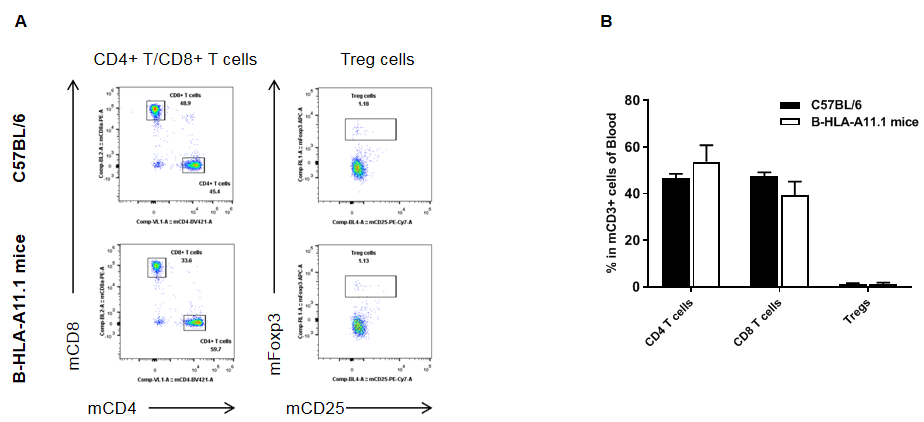
Analysis of blood T cell subpopulations by FACS. Blood cells were isolated from female C57BL/6 and B-HLA-A11.1 mice (n=3, 8-week-old). Flow cytometry analysis of the splenocytes was performed to assess leukocyte subpopulations. A. Representative FACS plots. Single live CD45+ cells were gated for TCRβ+ T cell population and used for further analysis as indicated here. B. Results of FACS analysis. The percent of Tregs in homozygous B-HLA-A11.1 mice were similar to those in the C57BL/6 mice. Percent of CD8+ T cells were significantly decreased while percent of CD4+ T cells were significantly increased, demonstrating that introduction of hB2M-HLA-A11.1-H-2D in place of mouse B2M may affected the development of CD8 + T cells, which in turn affected the proportion of T cell subtypes in the blood. Values are expressed as mean ± SEM.
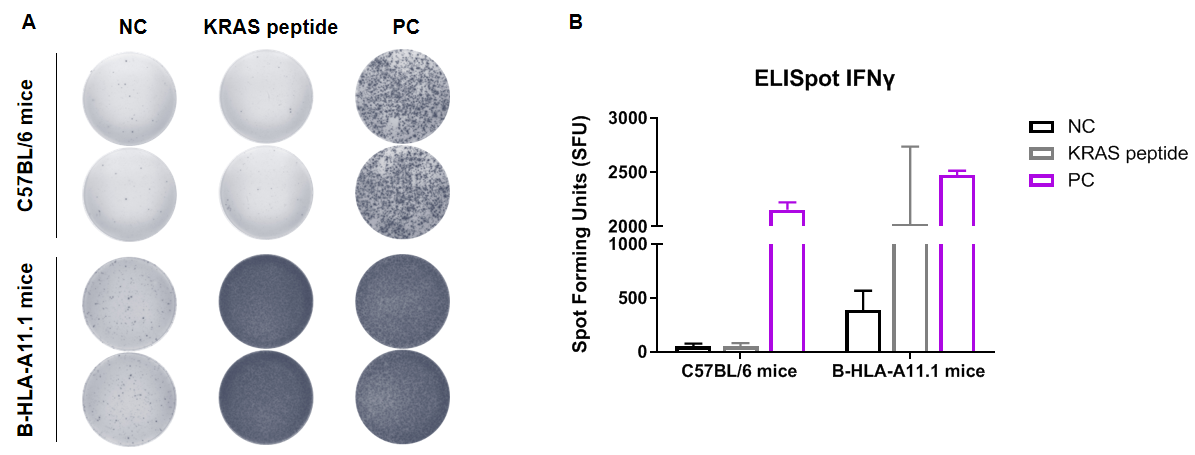
Detection of vaccine-induced immune responses in B-HLA-A11.1 mice by IFN-γ ELISpot assay. Female C57BL/6 mice and B-HLA-A11.1 mice at the age of 7–8 weeks were divided into PBS group and KRAS peptide group (n=2), and then inoculated PBS or vaccines at the inside muscle of both legs. Three weeks after the last immunization, mice were sacrificed. The splenocytes were extracted, stimulated with individual peptide or target-unrelated polypeptide as negative control (NC) or anti-CD3 as positive control(PC), and then measured for IFN-γ secretion. No significant difference in body weight among groups (Data was not shown). (A) Representative results showing stimulation of splenocytes harvested from immunized mice with negative control, or peptide vaccines, or positive control in duplicates. (B) Summary of results. The results demonstrate that B-HLA-11.1 mice provide a powerful preclinical model for in vivo evaluation of vaccines. NC: negative control, PC: positive control.
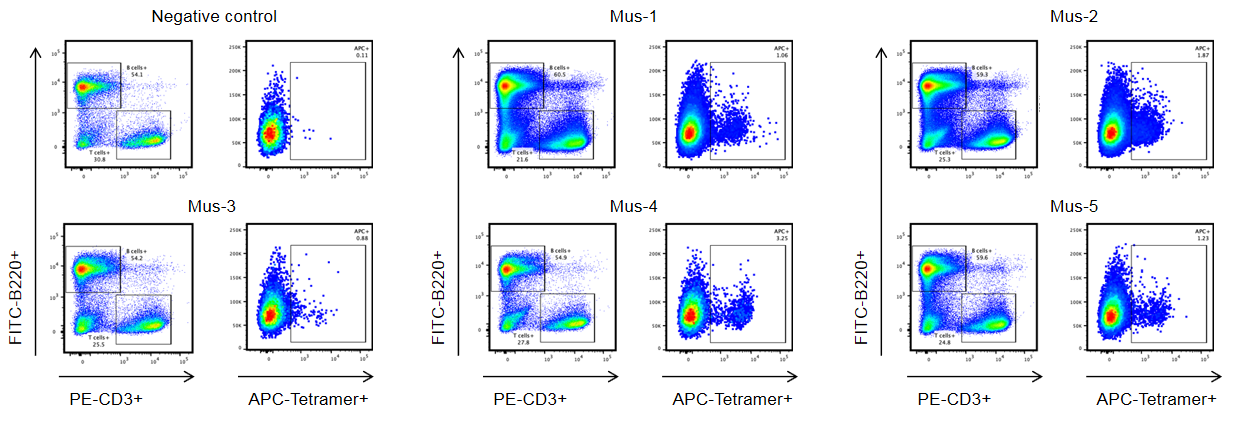
Single-cell isolation of target peptide-specific T cells from B-HLA-A11.1 mice. B-HLA-A11.1 mice were subcutaneously immunized with the target peptide and the spleen cells from five mice displayed specific responses against the target peptide. Spleen cells from five mice (Mus-1, Mus-2, Mus-3, Mus-4 and Mus-5) that showed substantial target peptide specific responses were stained with target peptide/HLA-A*11:01 tetramer, and the tetramer positive CD8+ T cells were sorted by single-cell sorting with flow Cytometry. Mouse without target peptide immunization was enrolled as the negative control. These results demonstrated that the B-HLA-A11.1 mice could be used for identifying target peptide specific TCRs and investigating mechanisms of peptide presentation and TCR recognition of cancer targets epitopes in the context of HLA-A*11:01 (All results were provided by the client.)

Antitumor activity of anti-mouse PD-1 antibody combined with KRAS*G12V mRNA vaccine against syngeneic tumors. (A) Experimental scheme. (B) Anti-mouse PD-1 antibody combined with therapeutic mRNA vaccine inhibited B-HLA-A11.1/hKRAS*G12V MC38 tumor growth in B-HLA-A11.1 mice. B-HLA-A11.1 mice were implanted subcutaneously with 1×106 B-HLA-A11.1/hKRAS*G12V MC38 tumor cells in the right flank, grouped when tumor volume reached approximately 100 mm3, at which time they were treated with anti-mouse PD-1 antibody or the mRNA vaccine with doses and schedules indicated in panel A. As shown in panel B, combination of anti-mPD-1 antibody and mRNA vaccine shows more inhibitory effects than individual groups, demonstrating that the B-HLA-A11.1 mice provide a powerful preclinical model for in vivo evaluating combination therapy efficacy of mPD-1 antibodies and the mRNA vaccine. C. Body weight changes during tumor growth observation. These results demonstrate that B-HLA-A11.1 mice provide a powerful preclinical model for in vivo evaluation of mRNA vaccines. Values are expressed as mean ± SEM.

Antitumor activity of anti-mouse PD-1 antibody combined with KRAS*G12V mRNA vaccine against syngeneic tumors. (A) Experimental scheme. (B) Anti-mouse PD-1 antibody combined with therapeutic mRNA vaccine inhibited B-HLA-A11.1/hKRAS*G12V MC38 tumor growth in B-HLA-A11.1 mice. B-HLA-A11.1 mice were implanted subcutaneously with 1×106 B-HLA-A11.1/hKRAS*G12V MC38 tumor cells in the right flank, grouped when tumor volume reached approximately 100 mm3, at which time they were treated with anti-mouse PD-1 antibody or the mRNA vaccine with doses and schedules indicated in panel A. As shown in panel B, combination of anti-mPD-1 antibody and mRNA vaccine shows more inhibitory effects than individual groups, demonstrating that the B-HLA-A11.1 mice provide a powerful preclinical model for in vivo evaluating combination therapy efficacy of mPD-1 antibodies and the mRNA vaccine. C. Body weight changes during tumor growth observation. These results demonstrate that B-HLA-A11.1 mice provide a powerful preclinical model for in vivo evaluation of mRNA vaccines. Values are expressed as mean ± SEM.
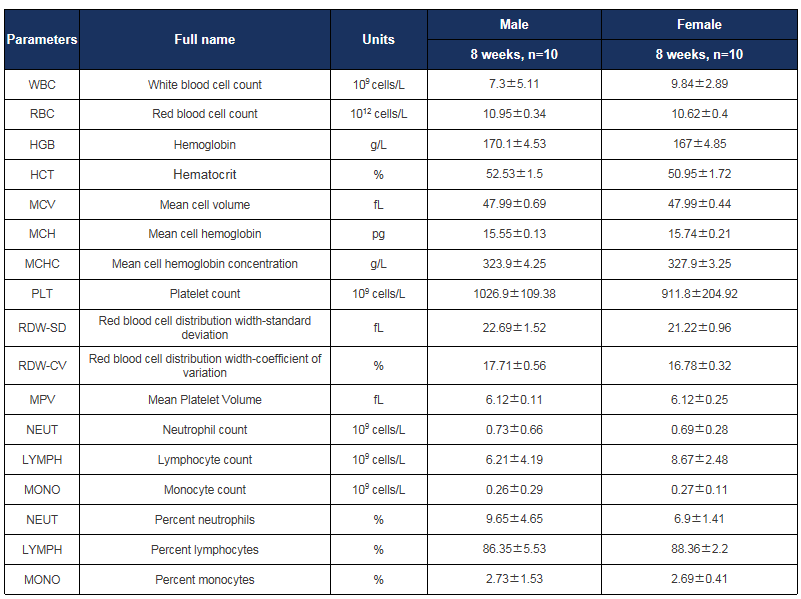
Complete blood count (CBC) of B-HLA-A11.1 mice. Values are expressed as mean ± SD.
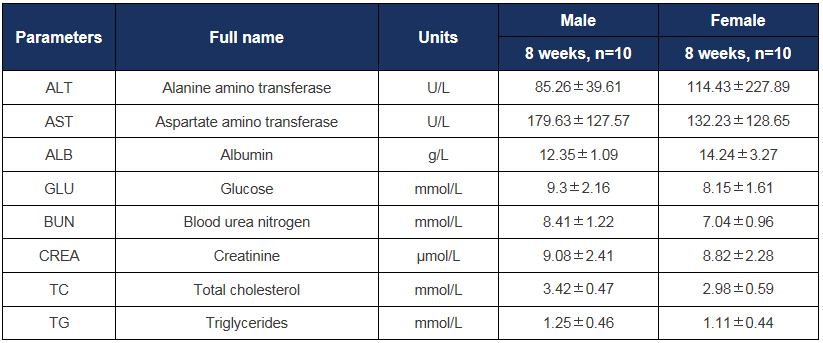
Biochemical test of B-HLA-A11.1 mice. Values are expressed as mean ± SD.

The organs of female B-HLA-A11.1 mice (8-week-old, n=10).

The organs of male B-HLA-A11.1 mice (8-week-old, n=10).
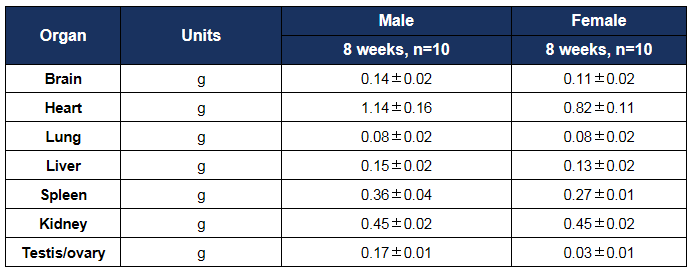
Average weight of the main organs of B-HLA-A11.1 mice. Values are expressed as mean ± SD.
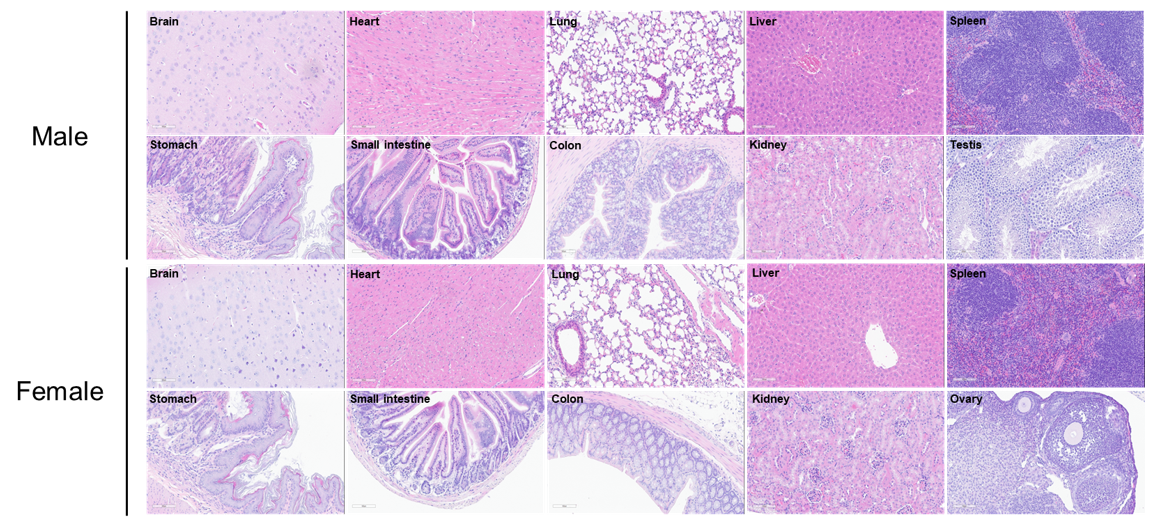
Histopathological analysis of organs in B-HLA-A11.1 mice. The main organs of B-HLA-A11.1 mice were isolated at 8 weeks of age and analyzed with H&E staining (male, n=10; female, n=10). Results showed that no obvious abnormalities were found in all of the organs (brain, heart, lung, liver, spleen, stomach, small intestine, colon, kidney, ovary and testis). Scale bar: 100 μm.

Antitumor activity of KRAS*G12V mRNA vaccine against syngeneic tumors. (A) Experimental scheme. (B) Antitumor activity of therapeutic treatment with mRNA vaccine. B-HLA-A11.1 mice (n=8) were vaccinated with PBS, LNP, or LNP-mRNA. B-HLA-A11.1 mice were implanted subcutaneously with 1×106 B-HLA-A11.1/hKRAS*G12V MC38 tumor cells in the right flank and immunized four times at 1-week intervals with PBS, LNP or mRNA vaccines via intravenous (i.v.) injection on days 0, 7, 14 and 21 after tumor volume reached approximately 100 mm3. As shown in panel B, the mRNA vaccines demonstrated robust inhibition of tumor growth and significantly prolonged overall survival compared to the control group. C. Body weight changes during tumor growth observation. These results demonstrate that B-HLA-A11.1 mice provide a powerful preclinical model for in vivo evaluation of mRNA vaccines. Values are expressed as mean ± SEM.